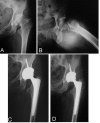Alumina-on-alumina total hip replacement for femoral neck fracture in healthy patients
- PMID: 21284879
- PMCID: PMC3038170
- DOI: 10.1186/1471-2474-12-32
Alumina-on-alumina total hip replacement for femoral neck fracture in healthy patients
Abstract
Background: Total hip replacement is considered the best option for treatment of displaced intracapsular fractures of the femoral neck (FFN). The size of the femoral head is an important factor that influences the outcome of a total hip arthroplasty (THA): implants with a 28 mm femoral head are more prone to dislocate than implants with a 32 mm head. Obviously, a large head coupled to a polyethylene inlay can lead to more wear, osteolysis and failure of the implant. Ceramic induces less friction and minimal wear even with larger heads.
Methods: A total of 35 THAs were performed for displaced intracapsular FFN, using a 32 mm alumina-alumina coupling.
Results: At a mean follow-up of 80 months, 33 have been clinically and radiologically reviewed. None of the implants needed revision for any reason, none of the cups were considered to have failed, no dislocations nor breakage of the ceramic components were recorded. One anatomic cementless stem was radiologically loose.
Conclusions: On the basis of our experience, we suggest that ceramic-on-ceramic coupling offers minimal friction and wear even with large heads.
Figures
Similar articles
-
Results of 200 Consecutive Ceramic-on-Ceramic Cementless Hip Arthroplasties in Patients Up To 50 Years of Age: A 5-24 Years of Follow-Up Study.J Arthroplasty. 2019 Jul;34(7S):S232-S237. doi: 10.1016/j.arth.2019.01.057. Epub 2019 Jan 31. J Arthroplasty. 2019. PMID: 30777621
-
A Minimum Ten Years of Follow-Up of Alumina Head on Delta Liner Total Hip Arthroplasty.J Arthroplasty. 2018 Feb;33(2):470-476. doi: 10.1016/j.arth.2017.08.043. Epub 2017 Sep 7. J Arthroplasty. 2018. PMID: 28958658
-
A minimum 20-year outcome of 100 consecutive alumina-on-alumina arthroplasties performed by a single surgeon.Hip Int. 2018 Nov;28(2_suppl):10-14. doi: 10.1177/1120700018813218. Hip Int. 2018. PMID: 30755120
-
[Large diameter femoral heads in primary alumina/alumina and XSPE/alumina total hip arthroplasty. A follow-up study of 50 hips after average 40 months and review of literature].Chir Narzadow Ruchu Ortop Pol. 2011 Jan-Feb;76(1):14-20. Chir Narzadow Ruchu Ortop Pol. 2011. PMID: 21850992 Review. Polish.
-
[Arthroplasty for intracapsular fractures of the femoral neck. Current concept review].Acta Chir Orthop Traumatol Cech. 2012;79(6):484-92. Acta Chir Orthop Traumatol Cech. 2012. PMID: 23286679 Review. Czech.
Cited by
-
The epidemiology of proximal femur fractures during COVID-19 emergency in Italy: a multicentric study.Acta Biomed. 2021 Nov 5;92(5):e2021398. doi: 10.23750/abm.v92i5.11925. Acta Biomed. 2021. PMID: 34738558 Free PMC article.
-
Two-year follow-up of revision total hip arthroplasty using a ceramic revision head with a retained well-fixed femoral component: a case series.J Med Case Rep. 2014 Dec 17;8:434. doi: 10.1186/1752-1947-8-434. J Med Case Rep. 2014. PMID: 25515611 Free PMC article.
-
Primary ceramic-on-ceramic total hip arthroplasty using a 32-mm ceramic head with a titanium-alloy sleeve.Clin Orthop Relat Res. 2015 Dec;473(12):3781-7. doi: 10.1007/s11999-015-4374-y. Clin Orthop Relat Res. 2015. PMID: 26024582 Free PMC article.
-
Dual-Mobility Cup Total Hip Arthroplasty for Displaced Femoral Neck Fractures: A Retrospective Study With a Median Follow-Up of 5 Years.Geriatr Orthop Surg Rehabil. 2021 Apr 30;12:21514593211013244. doi: 10.1177/21514593211013244. eCollection 2021. Geriatr Orthop Surg Rehabil. 2021. PMID: 34017615 Free PMC article.
References
-
- Garden RS. Stability and union in subcapital fractures of the femur. J Bone Joint Surg Br. 1964;46:630–47. - PubMed
-
- Geesink R. Prevention and treatment of recurrent dislocation after total hip arthroplasty. Eur Instr Course Lect. 2005;7:127–42.
-
- Bystrom S, Espehaug B, Furnes O, Havelin LI. Norwegian Arthroplasty Register Femoral head size is a risk factor for total hip luxation: a study of 42,987 primary hip arthroplasties from the Norwegian Arthroplasty Register. Acta Orthop Scand. 2003;74(5):514–24. doi: 10.1080/00016470310017893. - DOI - PubMed
-
- Hardinge K. The direct lateral approach. J Bone Joint Surg. 1982;64B:17–19. - PubMed
MeSH terms
Substances
LinkOut - more resources
Full Text Sources
Medical



